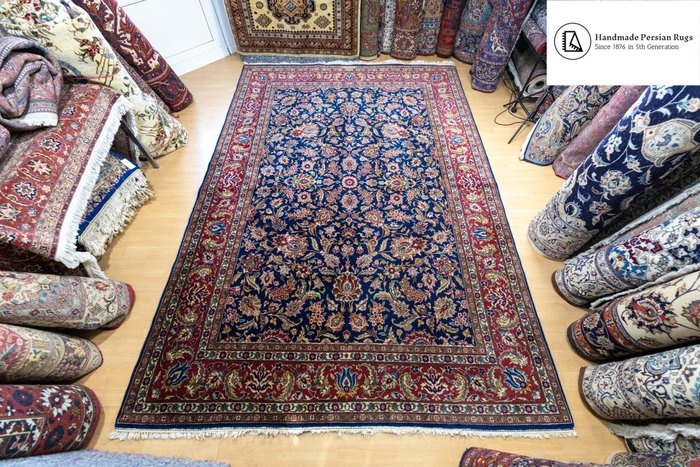Tabriz - Carpet - 355 cm - 244 cm
Hand-knotted Persian carpet Tabriz (Tabriz) floral pattern
Origin: Signed by Nemat-Nejad (see photos)
Knot density: approx. 100,000 knots/sqm
Condition: Very good condition with minimal signs of wear on the fringes, freshly washed (see photos)
Pattern: Tabriz Floral Pattern circa 1970
Material: virgin wool on cotton
This example is a rare Persian carpet in very good condition, signed by the Nemad Nejad workshop and knotted on both sides. The motifs appeared very frequently in the Persian carpets from “Täbriz” in the 1970s.
Tabriz, a city in northwestern Iran, has been famous for centuries for its hand-knotted carpets of exceptional quality and beauty. These carpets, often known as “Tabriz carpets,” embody the artistry and cultural heritage of the region and are valued worldwide for their fine craftsmanship.
The tradition of carpet making in Tabriz dates back to ancient times. It is believed that the art of knotting has been practiced in this region for more than 2,500 years. This long history and experience has resulted in a distinctive craftsmanship that is reflected in every Tabriz carpet.
What makes a Tabriz carpet special is its exceptional quality and variety. The carpets are made from the finest wool, cotton or silk and are characterized by their dense weave and rich colors. Designs vary from geometric patterns and floral motifs to historical and religious depictions. Each rug is unique and reflects the creative vision and craftsmanship of its creator.
Making a Tabriz carpet is a lengthy process that requires both patience and skill. First, the designs are carefully designed and drawn on paper by skilled craftsmen. Then the wool or silk threads of different colors are selected and spun by hand before being inserted into the weaving pattern.
Weaving a Tabriz carpet is an art that is passed down from generation to generation. Experienced rug weavers often work on a single rug for years, placing each knot with precision and care. This dedication to craftsmanship and attention to detail is what makes Tabriz rugs sought-after works of art.
The beauty and quality of Tabriz carpets have made them sought-after collector's items around the world. Collectors value not only their artistic beauty, but also their longevity and lasting value. An authentic Tabriz carpet can last for generations while maintaining its beauty and quality.
In addition, Tabriz carpets are not only decorative objects, but also symbols of wealth, prestige and cultural heritage. They are often prized as prestige objects in upscale homes and art collections, serving as a reminder of Iran's rich history and tradition of carpet making.
Overall, Tabriz carpets embody the timeless beauty and craftsmanship of a region known worldwide for its carpet-making tradition. Their fine details, vibrant colors and artistic motifs make them a sought-after work of art and an indispensable part of Iranian culture and humanity's cultural heritage.
View it on
Estimate
Time, Location
Auction House
Hand-knotted Persian carpet Tabriz (Tabriz) floral pattern
Origin: Signed by Nemat-Nejad (see photos)
Knot density: approx. 100,000 knots/sqm
Condition: Very good condition with minimal signs of wear on the fringes, freshly washed (see photos)
Pattern: Tabriz Floral Pattern circa 1970
Material: virgin wool on cotton
This example is a rare Persian carpet in very good condition, signed by the Nemad Nejad workshop and knotted on both sides. The motifs appeared very frequently in the Persian carpets from “Täbriz” in the 1970s.
Tabriz, a city in northwestern Iran, has been famous for centuries for its hand-knotted carpets of exceptional quality and beauty. These carpets, often known as “Tabriz carpets,” embody the artistry and cultural heritage of the region and are valued worldwide for their fine craftsmanship.
The tradition of carpet making in Tabriz dates back to ancient times. It is believed that the art of knotting has been practiced in this region for more than 2,500 years. This long history and experience has resulted in a distinctive craftsmanship that is reflected in every Tabriz carpet.
What makes a Tabriz carpet special is its exceptional quality and variety. The carpets are made from the finest wool, cotton or silk and are characterized by their dense weave and rich colors. Designs vary from geometric patterns and floral motifs to historical and religious depictions. Each rug is unique and reflects the creative vision and craftsmanship of its creator.
Making a Tabriz carpet is a lengthy process that requires both patience and skill. First, the designs are carefully designed and drawn on paper by skilled craftsmen. Then the wool or silk threads of different colors are selected and spun by hand before being inserted into the weaving pattern.
Weaving a Tabriz carpet is an art that is passed down from generation to generation. Experienced rug weavers often work on a single rug for years, placing each knot with precision and care. This dedication to craftsmanship and attention to detail is what makes Tabriz rugs sought-after works of art.
The beauty and quality of Tabriz carpets have made them sought-after collector's items around the world. Collectors value not only their artistic beauty, but also their longevity and lasting value. An authentic Tabriz carpet can last for generations while maintaining its beauty and quality.
In addition, Tabriz carpets are not only decorative objects, but also symbols of wealth, prestige and cultural heritage. They are often prized as prestige objects in upscale homes and art collections, serving as a reminder of Iran's rich history and tradition of carpet making.
Overall, Tabriz carpets embody the timeless beauty and craftsmanship of a region known worldwide for its carpet-making tradition. Their fine details, vibrant colors and artistic motifs make them a sought-after work of art and an indispensable part of Iranian culture and humanity's cultural heritage.



